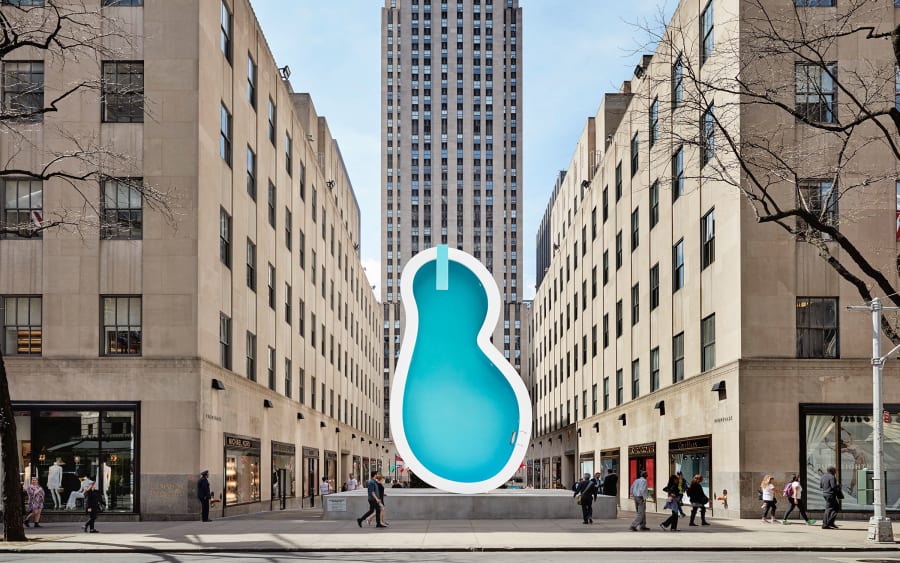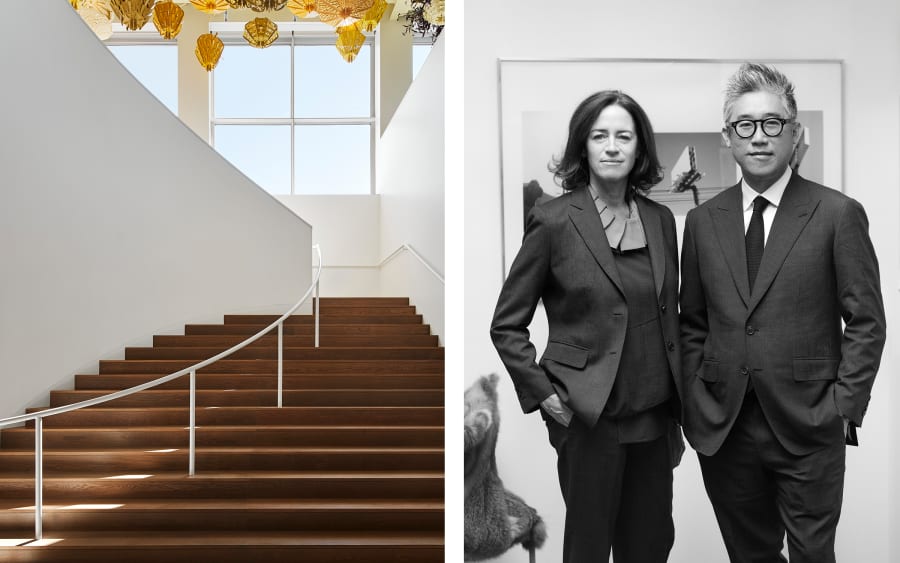Exhibition-making could be seen as a mathematical equation, with the artists, curators, and institutions on one side of the equal sign, and the exhibition as the solution. But one variable is often ignored. ‘Exhibition design is not particularly ‘seen’ in the artworld,’ explains Berlin-based architect Johanna Meyer-Grohbrügge.
For almost ten years, Meyer-Grohbrügge has been designing exhibitions for institutions including the Bauhaus Museum in Dessau and the Museum of Modern Art in Warsaw, as well as events such as the Berlin Biennale 2020. She has also created spaces for galleries and foundations, including the Julia Stoschek Foundation in Berlin. She sees herself as an equal partner in a ‘conglomerate of curators, artists, and museums,’ but, she tells me, ‘I’m not mentioned in many articles about [the] exhibitions [I design].’ Detlef Weitz has had similar experiences. The exhibition designer, who, with Sonja Beeck, runs Chezweitz, an office for museal and urban scenography in Berlin, says: ‘We do feel very valued by the museums we work with, but most art writers barely know our profession exists.’
The profession in question is loosely defined: Exhibition design can range from meticulously choreographing the viewer’s experience of a museum or a foundation as it’s being constructed, renovated, or rethought to creating wildly experimental structures for temporary blockbuster shows or biennials. It might encompass corporate identity or involve solving challenges relating to display, technology, and accessibility: how best to show video, sound, or digital art in difficult spaces, for instance, or accommodate those with physical or sensory limitations.
Chezweitz is one of a number of offices that – in addition to creating the infrastructure and choreographies of rotating art exhibitions – primarily organizes the experience of shows according to historical, social, and scientific topics. Along with their team, Beeck and Weitz have often worked for the Jewish Museum and the German Historical Museum, both in Berlin, among other venues. For the Moderna Museet in Stockholm, they developed monographic presentations on artists such as Louise Bourgeois, Hilma af Klint, and Lee Lozano. The same museum will soon mount an exhibition on the artist group Die Brücke, to a design by Chezweitz.
Some exhibition design offices specialize entirely in devising spatial narratives for museums, exhibition venues, and brands – like Gallagher Design in New York, Real Studios in London, and Atelier Brückner in Stuttgart. These designers see themselves as scenographers. Others are architects for whom creating shows or museum spaces is just one strand of a multifaceted practice. (Meyer-Grohbrügge works this way, as do Swiss firm Holzer Kobler Architekturen, among many others internationally.) ‘We love difficult spaces,’ says Weitz, citing the angular construction of Berlin’s Jewish Museum by star architect Daniel Libeskind as a prime example. When they took on the task of setting up a new permanent exhibition there, Weitz and Beeck were ready for the challenge. ‘You have to take the space very seriously and very carefully, and work with it,’ he says.
Why is exhibition design so under-appreciated by the public? One reason is that viewers barely notice the work, especially when it’s done well. If they do, they tend to see it merely as a technical necessity supporting the artwork: the wall and lighting that set the scene for a painting; the plinth for a sculpture; the projector and headphones for a video installation. The second reason might be that ‘making’ an exhibition – including its concept, narrative, and sequence – is considered the curator’s job. Sometimes, for financial reasons, it is. ‘In many of the institutions I’ve worked for, there wasn’t much of a budget for exhibition design,’ says curator Michelle Cotton, who took over as artistic director of the Kunsthalle Wien in Vienna this year, but was previously program director at the Museum of Contemporary Art Luxembourg (MUDAM). ‘Commissioning artists to create new work was a larger priority for us.’
Cotton has worked with exhibition designers for larger group shows like ‘Radical Software: Women, Art and Computing 1960–1991’, which opens on September 20 at MUDAM. For her, spaces should be visually stimulating and engaging, to encourage people to visit, while the exhibition design should offer gallery-goers orientation and information – but not too much. ‘As humans, we have the ability to understand and make sense of things, even if they are as multilayered and complex as contemporary art,’ says Cotton. Meyer-Grohbrügge has often collaborated with curators and understands this complexity. When she is brought in to design a show, her exchange with the teams in the institutions is at the core of the project. ‘The curatorial concept and intention are very important,’ she explains. ‘What do you actually want to say with the exhibition?’ After discovering the answer to this question, she then tries to ‘spatialize’ it. Visitors should understand the exhibition ‘not just through the wall text, but also through a physical experience in the space.’
What role do artists play in mounting a compelling exhibition? ‘All artists ultimately have the same medium – namely, the exhibition – and the exhibition as a medium is extremely rich,’ says Rio de Janeiro-based artist Daniel Steegmann Mangrané. He combines his installations, films, sound pieces, photographs, drawings, and sculptures into carefully staged spaces, as was recently the case in his retrospective ‘A Leaf Shapes the Eye’ (which closed in May this year) at the Museu d'Art Contemporani de Barcelona (MACBA) in Barcelona. ‘People think with their bodies and movement; the mind is a muscle. So, by changing the conditions of the viewer’s body, you can change their mindset, and influence the way they act or interact,’ he explains. The potential for such transformations is what makes the exhibition ‘medium’ so rich for him. When Steegmann Mangrané collaborates in designing his own shows, he tries to draw the viewer’s attention away from the artworks and toward their own physical presence in the space, instead. He might achieve this with curtains made of thin metal chains interspersed with irregular openings. ‘The work changes as you move through the different levels, and you become more and more aware of your body and your movement in a space that you traverse,’ he says.
The viewer’s embodied experience has risen in importance in recent years, but so has another issue: sustainability. After all, apart from permanent collection presentations, exhibitions are, by their very nature, a temporary medium. While it was once common practice to tear out and dispose of partition walls, plinths, display cases, and cabling at the end of a show, such an act would be unthinkable today. This shift in attitude has led to new solutions, such as those used to stage ‘Post-Capital: Art and the Economics of the Digital Age’, a video exhibition curated by Cotton at MUDAM in 2021. Instead of building a separate, soundproofed room for each of the works, the installation team opted to show them in a large space, and visitors were given wireless headphones that connected to the soundtrack for each piece as they walked around the space. In many institutions, it is also common practice to work with modular materials and to reuse wall panels and display cases. (The same goes for art fairs: Art Basel, too, has turned to reuse as much as possible.)
As the equations adding up to major exhibitions become more complex, with an increasing number of variables, it’s time to take a closer look at the math. Hopefully, in the future, the achievements of exhibition designers – those behind-the-curtains scenographers shaping our experiences of art – will be recognized alongside those of artists, curators, and institutions, as they so justly deserve.
Jasmin Jouhar is a Berlin-based writer, creator, and strategist in the fields of architecture and design.
Caption for top image: Opening of the exhibition Never Again - Art against War and Fascism in the 20th and 21st Centuries at the Museum of Modern Art in Warsaw, 2019. Photo: © MG. Courtesy of Johanna Meyer-Grohbrügge.
Published on September 3, 2024.


